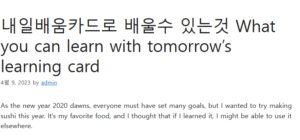As the new year 2020 dawns, everyone must have set many goals, but I wanted to try making sushi this year. It’s my favorite food, and I thought that if I learned it, I might be able to use it elsewhere.
I found out that it was supported by the government, and last year it was divided into job seekers (unemployed) and incumbents (workers) Tomorrow Learning Card, but it was integrated in 2020. 내일배움카드로 배울수 있는것

Since January 2020, various changes have occurred, such as an increase in the validity period and support amount, as it was integrated into the National Tomorrow Learning Card. 좋은뉴스
Let’s find out sequentially, such as what has changed, how to use it, what can be learned with the National Tomorrow Learning Card, and how much it costs.
National Tomorrow Learning Card application qualifications and application method
If you search for the National Tomorrow Learning Card, you will find the HRD-Net site.
Anyone can apply for the Kookmin Tomorrow Learning Card. However, public servants, persons eligible for private school pension, students, workers at large companies with a certain wage or higher, some high-income self-employed persons, and workers in special employment types are excluded.
Regardless of unemployment, employment, or self-employment, if you apply for one Kookmin Tomorrow Learning Card, you can use it for 5 years, and training expenses of 3 to 5 million won per person are supported.
It is the same for training participants to bear part of the training costs, but the ratio of self-pay to the unemployed, employed, and self-employed has become the same, and low-income class and national strategic industry training participants do not have to pay.
The Naeil Learning Card for the unemployed (job seeker) and the Naeil Learning Card for the incumbent (worker) were originally separate, had different validity periods, and the amount of subsidy was low.
Anyone can apply, the validity period has been extended to 5 years, training for national strategic industry occupations is fully supported, individualized classes + HRD-Net can be checked in real time, and the self-pay ratio is the same for the unemployed, employed, and self-employed It’s done.
In the past, if the unemployed, incumbents, and incumbents were centered on small and medium-sized businesses or non-regular workers, now anyone can use it.
The amount of support has also increased from the original 2 to 3 million won to 3 to 5 million won and has been consolidated into one piece, resulting in many positive changes.
What can be learned with the National Learning for Tomorrow Card
If you applied for it and received it, you should use it. Search the job training portal and enter HRD-Net.
In fact, everything is possible here, including card application, training search, online course registration, and card details inquiry.
The name of the card has been changed to the National Tomorrow Learning Card, but the detailed search for training is still divided into job seekers (unemployed) and workers (employees).
However, there is no difference as long as it is integrated into one piece.
I entered big data in the training process and searched nationwide without selecting a region just in case.
This is one of the trainings that are fully government-sponsored as mentioned earlier. In addition to this, all training related to design or national strategic industries is fully supported by the government.
Now it’s time to figure out your out-of-pocket costs.
I first said that I wanted to make sushi, so I searched for sushi. I tried to search for Japanese food, but I searched for sushi.
Fortunately, there is one in Seoul and another in Busan. For reference, if you search for Japanese food instead of sushi, you can see more results.
Based on where you are in Seoul, the training fee is 1,475,500 won. Click on the small section next to View Out-of-Pocket Amount.
Out of 1,475,500 won, the amount I have to pay is 797,230 won, which is about 50%.
This varies depending on the industry I want to be trained in and the employment rate, so I searched for various things, and I was able to see as little as 25% and as much as 50%.
In the case of participants in the Employment Success Package (Chwiseongpae) or recipients of work incentives, the amount of self-burden is further reduced, so you can choose the one that suits you.